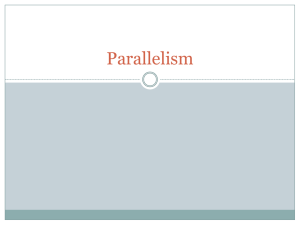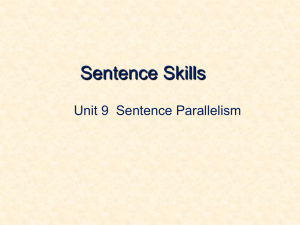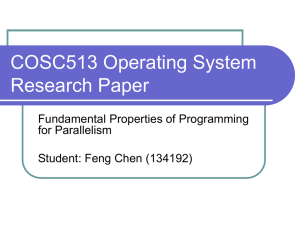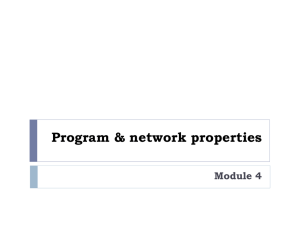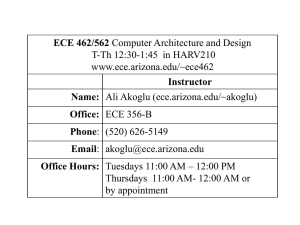Programmability Issues
advertisement
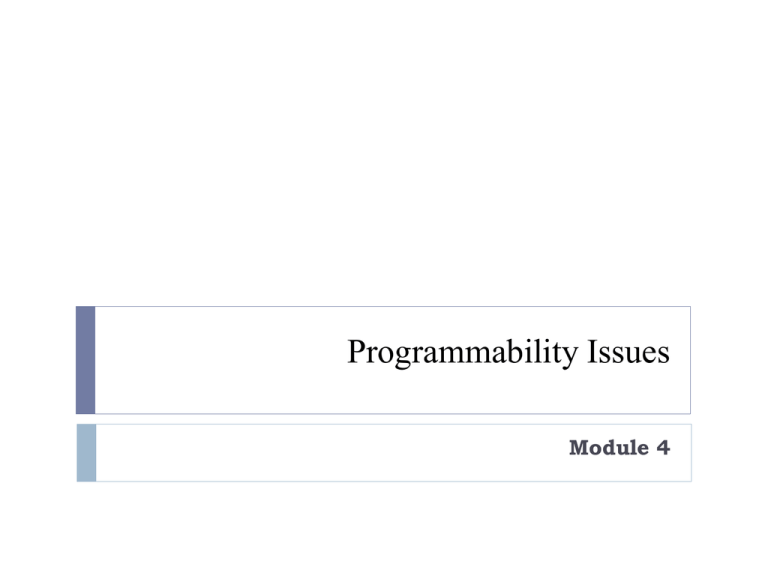
Programmability Issues
Module 4
Points to be covered
Types and levels of parallelism
Operating systems for parallel processing, Models of
parallel operating systems-Master-slave configuration,
Separate supervisor configuration, Floating supervisor
control
Data and Resource Dependences, Data
dependency analysis-Bernstein’s condition
Hardware and Software Parallelism
Types and Levels Of Parallelism
1)
2)
3)
4)
5)
Instruction Level Parallelism
Loop-level Parallelism
Procedure-level Parallelism
Subprogram-level Parallelism
Job or Program-Level Parallelism
Instruction Level Parallelism
This fine-grained, or smallest granularity level typically
involves less than 20 instructions per grain.
The number of candidates for parallel execution varies
from 2 to thousands, with about five instructions or
statements (on the average) being the average level of
parallelism.
Advantages:
There are usually many candidates for parallel execution
Compilers can usually do a reasonable job of finding this
parallelism
Loop-level Parallelism
Typical loop has less than 500 instructions. If a loop
operation is independent between iterations, it can be
handled by a pipeline, or by a SIMD machine.
Most optimized program construct to execute on a
parallel or vector machine. Some loops (e.g. recursive) are
difficult to handle.
Loop-level parallelism is still considered fine grain
computation.
Procedure-level Parallelism
Medium-sized grain; usually less than 2000 instructions.
Detection of parallelism is more difficult than with
smaller grains; interprocedural dependence analysis is
difficult.
Communication requirement less than instruction level
SPMD (single procedure multiple data) is a special case
Multitasking belongs to this level.
Subprogram-level Parallelism
Grain typically has thousands of instructions.
Multi programming conducted at this level
No compilers available to exploit medium- or coarsegrain parallelism at present
Job Level
Corresponds to execution of essentially independent jobs
or programs on a parallel computer.
This is practical for a machine with a small number of
powerful processors, but impractical for a machine with a
large number of simple processors (since each processor
would take too long to process a single job).
Data dependence
The ordering relationship between statements is
indicated by the data dependence. Five type of data
dependence are defined below:1) Flow dependence
2) Anti dependence
3) Output dependence
4) I/O dependence
5) Unknown dependence
Flow Dependence
A statement S2 is flow dependent on S1 if an execution
path exists from S1 to S2 and if at least one output
(variables assigned) of S1 feeds in as input(operands to be
used) to S2 and denoted as-:
S1->S2
Example-:
S1:Load R1,A
S2:ADD R2,R1
Anti Dependence
Statement S2 is antidependent on the statement S1 if S2
follows S1 in the program order and if the output of S2
overlaps the input to S1 and denoted as :
S1 S2
Example-:
S1:Add R2,R1
S2:Move R1,R3
Output dependence
Two statements are output dependent if they produce
(write) the same output variable.
Example-:
Load R1,A
Move R1,R3
I/O
Read and write are I/O statements. I/O dependence
occurs not because the same variable is involved but
because the same file referenced by both I/O statement.
Example-:
S1:Read(4),A(I)
S3:Write(4),A(I)
Unknown Dependence
The dependence relation between two statements cannot
be determined.
Example-:Indirect Addressing
S1 Load R1, A
S2 Add R2, R1
S3 Move R1, R3
S4 Store B, R1
Flow dependency
S1to S2
S3 to S4
S2 to S2
Anti-dependency
S2to S3
Output dependency
S1 toS3
Control Dependence
This refers to the situation where the order of the
execution of statements cannot be determined before
run time.
For example all condition statement,where the flow of
statement depends on the output.
Different paths taken after a conditional branch may
depend on the data hence we need to eliminate this data
dependence among the instructions.
This dependence also exists between operations
performed in successive iterations of looping procedure.
Control dependence often prohibits parallelism from
being exploited.
Control-independent example:
for (i=0;i<n;i++) {
a[i] = c[i];
if (a[i] < 0) a[i] = 1;
}
Control-dependent example:
for (i=1;i<n;i++) {
if (a[i-1] < 0) a[i] = 1;
}
Control dependence also avoids parallelism to being
exploited.
Compilers are used to eliminate this control dependence
and exploit the parallelism.
Resource dependence
Resource independence is concerned with conflicts in
using shared resources, such as registers, integer and
floating point ALUs, etc. ALU conflicts are called ALU
dependence.
Memory (storage) conflicts are called storage
dependence.
Bernstein’s Conditions
Bernstein’s conditions are a set of conditions which must
exist if two processes can execute in parallel.
Notation
Ii is the set of all input variables for a process Pi
. Ii is also called the read set or domain of Pi.
Oi is the set of all output variables for a process Pi .Oi is also
called write set.
If P1 and P2 can execute in parallel (which is written as P1 ||
P2) then we should have-:
In terms of data dependencies, Bernstein’s conditions
imply that two processes can execute in parallel if they
are flow-independent, antiindependent, and
outputindependent.
The parallelism relation || is commutative (Pi || Pj implies Pj
|| Pi ), but not transitive (Pi || Pj and Pj || Pk does not imply Pi
|| Pk )
Hardware and software parallelism
Hardware parallelism is defined by machine architecture.
It can be characterized by the number of instructions that
can be issued per machine cycle. If a processor issues k
instructions per machine cycle, it is called a k-issue
processor.
Conventional processors are one-issue machines.
Examples. Intel i960CA is a three-issue processor
(arithmetic, memory access, branch). IBM RS -6000 is a
four-issue processor (arithmetic, floating-point, memory
access, branch)
Software Parallelism
Software parallelism is defined by the control and data
dependence of programs, and is revealed in the program’s
flow graph i.e., it is defined by dependencies with in the
code and is a function of algorithm, programming style,
and compiler optimization.
The Role of Compilers
Compilers used to exploit hardware features to improve
performance.
Interaction between compiler and architecture design is a
necessity in modern computer development. It is not
necessarily the case that more software parallelism will
improve performance in conventional scalar processors.
The hardware and compiler should be designed at the
same time.
Operating System For Parallel Processing
There are basically 3 organizations that have been
employed in the design of operating system for
multiprocessors. They are :-
1)Master Slave Configuration
2)Separate Supervisor Configuration
3)Floating Supervisor Configuration
This classification applies not only to operating system,
but in general, to all the parallel programmming strategies.
Master Slave Configuration
In the master slave mode, one processor, called master,
maintains the status of all the other processors in the
system and distributes the works to all the slave
processors.
The operating system runs only on master processor and
all other processor are treated as schedulable resources.
Other processors needing executive service must request
the master that acknowledges the request and performs
the services.
This scheme is a simple extension of uniprocessor
operating system and is fairly easy to implement.
The scheme, however makes the system extremely
susceptible to failures.(What if the master fails?)
Many of the slaves have to wait for master’s work to get
over,before they can get their request served.
Separate Supervisor System
Here in this approach each processor contains the copy
of kernal.
Resource sharing occurs via shared memory blocks.
Each processor services its own needs.
If the processor access the shared kernal code,then the
code must be reentrant.
Separate supervisor system is less susceptible to failures.
This scheme however demands excess resources for
maintaining copies of tables describing resource allocation
etc for each of the processors.
Floating Supervisor Control
The supervisor routine floats from one supervisor to
another,although several of the processor may be
executing supervisory service routines simultaneously.
Better Load balancing
Several amount of code sharing,so code must be
reentrant.
Generally one sees a combination of above schemes to
obtain a useful solution.
End Of Module 4
